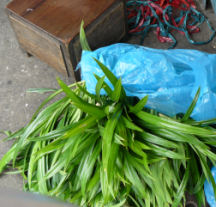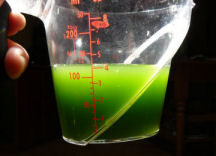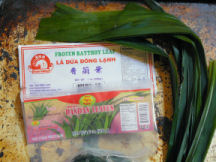Asian ingredients can confuse with all the various names in their native languages and then the English term(s) for them. This afternoon, Phu emailed asking for the English name for lá dứa, a common southern Viet ingredient. They’re called pandan leaf in English. They’re also called screwpine leaf, which isn’t very nice sounding!
Dứa is also the name for pineapple in Vietnamese and I once caught my father explaining to my non-Viet husband that lá dứa were the leaves of the pineapple. That’s wrong, Daddy. Stop. They’re not related! A pretty full listing of names for pandan is at wikipedia.com.
Pandan leaves (Pandanus latifolius, P. amaryllifolius) look like gladiola leaves. They’re narrow, long and pointed at the tip. When attached to their stems, they resemble giant green feather dusters. (See the top photo taken at a neighborhood wet market in Saigon last March 2008.)
They have a grassy herby flavor and can be tied in a knot and added to rice, both long grain and sticky rice. Cooks also use them in desserts by extracting their liquid, traditionally done by pounding on the leaves but I do it in the blender or mini-chopper with a little water. The green result is striking in color, kind of like super wheat grass in smell and looks. Once cooked, the color turns to a celadon green, and there’s a subtle hint of the herby quality.
Đang xem: Lá dứa tiếng anh là gì
Below is strained pandan juice that I got from cutting up 4 to 6 large leaves into 1-inch pieces and whirring with 1/2 cup water.
Many cooks add a little green food coloring to cheer up the pandan extract but the result is a little Christmas-y to me. Pandan leaves can also be used to wrap food up in and then grilled, though I’ve not been overly impressed with that application. Pandan can be woven into small containers too.
In the Vietnamese kitchen, pandan is basically a southern ingredient. I’ve seen reference to it in old cookbooks that call for lining steamer trays with the leaves and then steaming sticky rice over it for flavor. In fact, an alternative name for lá dứa is cây cơm nếp (tree for sticky rice). Abroad, pandan is mostly available frozen, though I can get fresh in San Jose and Orange County, California. Floridians have told me that the plant grows very well there.
Aside from culinary uses, it seems that pandan may be good for controlling diabetes too. That’s the latest from the Vietnamese community, per Phu who was asking about the English name for lá dứa. Drinking a tea made with pandan leaf has helped a few people combat or reduce the threat of diabetes – a growing problem among Vietnamese Americans whose diets have gotten richer and lives more sendetary since their arrival in the States. Phu will be trying it out and reporting back!
Though I watch what I eat, I frankly focus on the food more. I was raised by a mom who hailed from northern Vietnam so I'm relatively new to pandan. Over the past year or so, I've been experimenting and here are some tips:
When using pandan for sweets, I’ve found that it marries exceptionally well with coconut milk, especially when a touch of vanilla is added to bring out the herbal quality of both the coconut milk and the pandan. Make sure to add some sugar and 1 to 2 pinches of salt.Use a lot of leaves or the result will just be so subtle you’ll think the leaves weren't worth the trouble. Try to avoid the bottled extract, which tastes of chemicals.Smash the leaf a little before knotting it and adding it to cook rice, etc, to ensure that the essence releases.
What are your favorite ways or tips for using the green leaf?


